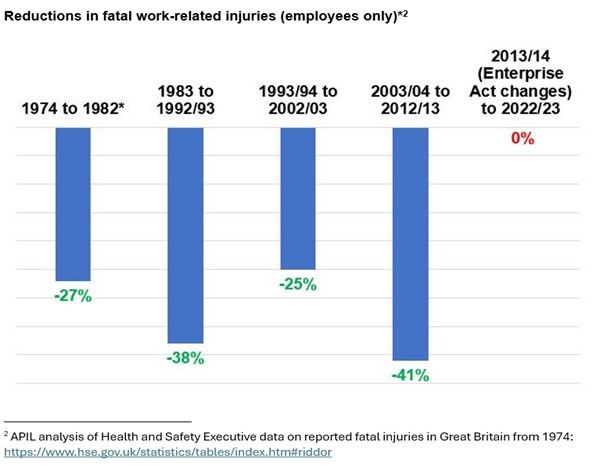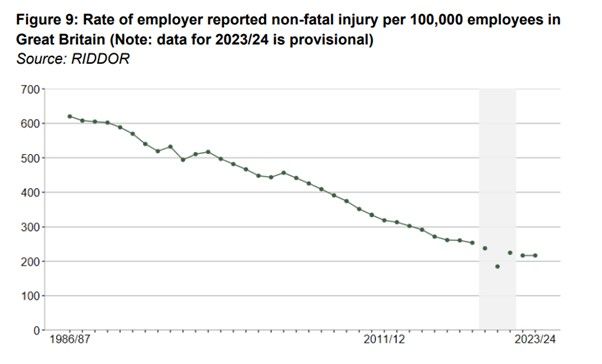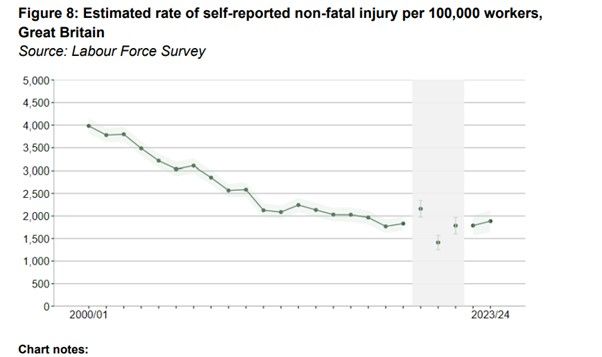International Workers' Memorial Day - Where is health and safety in the UK after 50 years of the HSE?

This year marks the 50th anniversary of the establishment of the Health and Safety Executive (HSE), and it is opportune to consider the impact of the HSE on the day that we formally acknowledge those that have lost their lives in the workplace.
Created by the Health and Safety at Work etc Act 1974, the HSE has come to form a vitally important part of our society with its remit to enforce health and safety legislation in workplaces across the country.
This significant anniversary reminds us of the importance of the HSE statistics providing an overview of levels of accident and ill-health in the nation’s workplaces. It is appropriate to consider progress over those fifty years.
The headline summary would suggest that from having seen significant improvements in the nation’s workplace safety over a few decades, the last ten to fifteen years have seen a plateauing amid some considerable concerns.
Let’s start with the most serious of the statistics – fatalities within the workplace. 138 people died at work in 2023/24 – up 2 from the previous year. In 1974, 651 employees lost their lives in the workplace. In 1993/94 that figure was over 300, and a decade later, in 2002/03, it had dropped to 226. By 2012/13, the number was 136, and that is where the figures have largely remained, within a range of 5-10 either side of 140.
The construction and agriculture, forestry and fishing sectors continue to be responsible for the greatest number of workers killed each year, accounting for around one half of the total.
Around 70% of fatal injuries involve falls from height, being struck by a moving vehicle or by a moving object.
The following graph, produced by the Association of Personal Injury Lawyers (APIL), illustrates the fall in fatalities over the period since 1974 and more recent lack of further decrease.

Reported workplace injuries have shown a similar pattern. In 1974, over 336,000 non-fatal injuries were reported. By 1993/94 that figure had more than halved to 151,000, which was the ballpark for a further decade or so, and then a further decrease to 60-70,000 a year since 2015/16. 61,663 was the number last year, up from 60,645 the previous year.

It should be borne in mind that for over 20 years the Labour Force Survey have consistently estimated that the actual incidence of workplace injuries is significantly higher, ranging from over 1 million in 2000/01 to 550-650,000 in each of the last 14 years, other than the main Covid affected year of 2020/21.

Again, we see significant decreases over the longer period, but in recent years that progress has stalled.
We must be conscious of the effect on productivity and the workforce. The HSE estimate that 33.7m working days were lost as a result of ill health and workplace injury last year, down from 37m the previous year, but still over 6m more than the 27.4m days lost in 2014/15, and continuing a trend whereby the number of days lost is on an upward trajectory.
There is a cost in monetary terms as well, with an estimated increase in the cost to the economy from £14.3bn in 2014/15, to £20.7bn in 2022/23, to £21.6bn last year. The cost to the NHS alone is around £1bn a year.
It is of significant concern that in 2023/324 some 736,000 workers sustained a work-related injury which necessitated 7 days or more absence, or became ill because of their work. That is a 16% increase since 2018/19. Over the same period work related injury and illness claims have decreased by 50%.

It is clear that in the first four decades of the HSE, there were significant improvements in workplace safety. Fatal and reported injuries fell sharply. The creation of the HSE, with its regulatory and enforcement powers has led to a much safer environment.
The ability to bring civil claims, relying on breaches of health and safety regulations, has also played its part. Employer behaviour improves markedly when the level of insurance premiums is dependent on claims record. It is surely not a coincidence that the halt in the falling rates of fatalities and reported injuries has come about during the period since the removal of the right to rely on those breaches.
Times of economic uncertainty and challenge do lead to employers cutting corners, not paying their insurance premiums, and taking risks with workers’ lives. A reduction in the resources available to agencies such as the HSE add to the mix.
What can be done?
- Establishment of an Employers Liability Insurers Bureau. The template is there with the Motor Insurers Bureau.
- Repeal of section 69 of the Enterprise and Regulatory Reform Act 2013.
- Active enforcement of Compulsory Liability Insurance provisions
- Increase resource to the HSE to allow effective inspection and enforcement
Whilst we have to acknowledge that public finances are extremely tight, taking the appropriate measures and providing investment in the right place, in the right way and at the right time, will lead to clear savings, not just financially, but far more significantly, in terms of workers’ safety and lives.

Gordon Dalyell, Partner